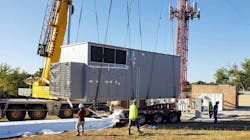In an early test of how edge computing will integrate with traditional data center infrastructure, data center developer Digital Realty and edge computing specialist Vapor IO are rolling out an “edge-to-core” offering in Chicago, Dallas and Atlanta, the companies said today.
Today’s announcement is the first fruits of the partnership between the two companies, who hold leadership positions in the markets for wholesale data center space and edge-based colocation. The solution is designed to make it easier for joint customers to deliver low-latency edge applications.
“There’s no combination stronger than the largest data center player in the world, and the best capitalized edge startup,” said Cole Crawford, the CEO of Vapor IO” We can execute on the announcements we make. We know the industry is ready and the market is ready.”
Edge computing moves data processing and services as close to the end user as possible. The trend is driven by the increased use of consumer mobile devices, especially consumption of video and virtual reality content and the growth of sensors as part of the Internet of Things.
In our 2020 forecast, Data Center Frontier predicted the edge computing sector would get down to business, with a sharpened focus on commercial deployments and revenue.
The partnership provides access to edge infrastructure for Digital Realty customers, and is a significant vote of confidence for Vapor IO as it continues to build its network in a fragmented edge computing landscape. The initial 3-market deployment allows companies to test and validate new edge-native applications and workflows that connect and coordinate traffic exchange between PlatformDIGITAL and Vapor IO’s Kinetic Edge deployments.
“We’ve always said the first ‘killer apps’ for the edge would be economics and the proverbial easy button,” said Crawford. “Our collaboration with Digital Realty combines the cloud proximity, core, regional edge and interconnect capabilities of PlatformDIGITAL with the low-latency, distributed architecture of our Kinetic Edge service, offering a combined edge-to-core platform that is already enabling valuable emerging use cases.”
Better Density and Latency in Key Data Hubs
The joint offering is an early entry in the bid to extend digital infrastructures in both breadth and density. Edge computing offers the opportunity to extend networks beyond the core data center markets, but also to offer more and faster connections between data services and consumers.
Digital Realty operates 275 data centers across the globe, including carrier hotels and scale-out data center clusters in Chicago, Dallas and Atlanta – the three markets where Vapor IO has deployed its Kinetic Edge architecture. The companies plan to expand the concept to additional cities as Vapor IO continues the national buildout of its network, which is planned to grow to 36 sites.
What types of applications will benefit? Chris Sharp, the Chief Technology Officer of Digital Realty, says the company has some ideas about use cases, but will continue to pay close attention to customer feedback.
“What core-to-edge means to the customer is that they can build a multi-tier application, which really enables new use cases,” said Sharp. “We’re looking for customers to come and prove our core-to-edge value proposition.
“Artificial Intelligence impacts every vertical,” said Sharp. “AI doesn’t just resolve in the core data centers. There are variants that will be pervasively deployed in devices at the edge. Customers can use these capabilities to innovate in ways that we can’t necessarily see today.”
Other edge computing use cases include:
- 4G & 5G Networks: Build public and private networks that leverage neutral hosts that can support virtualization efforts for both core market sites as well as edge sites in close proximity to RAN aggregation points.
- IoT and Robotics: Augment the real world with smart machines, including telemetry control from the edge, storage at the core, and give machines the power to see with distributed AI.
- Autonomous Vehicles: Safety and performance enhanced with distributed AI and supported by core-to-edge infrastructure on land, sea or air, with large-scale training and data storage at the core.
- Augmented Reality: Solving industrial, professional and personal AR together with real-time AI inferencing and rendering at the edge, as well as training, content generation and storage at the core.
Customers can work with solution architects from Digital Realty and Vapor IO to optimize deployments for specific use cases.
A Network-Centric View of Edge Computing
Vapor IO is creating a distributed network of edge colocation sites, housed in micro modular data centers that can be deployed at key points on the network, including telecom towers and antenna sites. The Kinetic Edge is Vapor IO’s network design, which uses both wired and wireless connections to create a reliable, low-latency network of colocation sites.
Vapor IO has completed a Series C funding of $90 million from existing investors Berkshire Partners and Crown Castle.
“Our industry takes capital, and we’re the most capitalized edge company in the data center market,” said Crawford, who said projects are now in development in all 36 target markets. “All of these cities are actively being deployed. It is not a plan. This is being built.”
In its approach to the edge market, Vapor IO has taken a broad approach that combines a focus on software-driven management with expertise in networking and data center hardware – including its distinctive round Vapor Module rack enclosure.
“We’ve never thought of the edge as an isolated micro modular data center,” said Crawford. “The real value of the Kinetic Edge is the value of the connection. You now have all the ingredients with that edge to core continuum.
“It takes wires to offer wireless,” he continued. “You need a network for this to be meaningful. We’re seeing more companies figure this out. This middle mile serves as the bridge connecting the access network to the core of the Internet. You need fiber density to do end-to-end latency.”
That approach got the attention of Digital Realty. “One of the things we have always liked about Vapor IO, is that they’re not a container or just a piece of software,” said Sharp.






